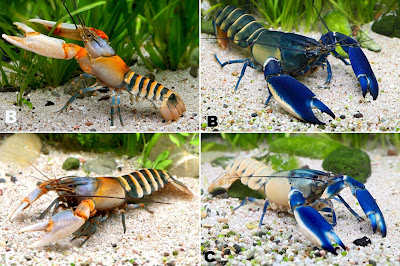 |
| Cherax rayko Cherax phing Lukhaup, Eprilurahman & von Rintelen, 2024 |
Abstract
Two new species of the genus Cherax are described and illustrated. Cherax rayko n. sp., endemic to the Bian River drainage basin in the Muting District, in the northern part of the Merauke Regency, South Papua, Indonesia, is described, figured, and compared with its closest relatives, Cherax alyciae, Lukhaup, Eprilurahman & von Rintelen, 2018, and Cherax peknyi Lukhaup & Herbert, 2008. The new species may be easily distinguished from both by the shape of the rostrum, the shape of the chelae, the shape of the scaphocerite, and the coloration. Cherax phing n. sp., endemic to the Kali Ombak River drainage basin in the western part of the Kepala Burung (Vogelkop) Peninsula, Southwest Papua, Indonesia, is described, figured, and compared with its closest relatives, Cherax pulcher Lukhaup, 2015a, Cherax boesemani Lukhaup & Pekny, 2008, Cherax wagenknechtae Lukhaup and Eprilurahman, 2022, and Cherax gherardii Patoka, Bláha & Kouba, 2015. The new species may be easily distinguished from the latter species by the shape of the chelae, rostrum, and body and by the coloration. A molecular phylogeny based on a mitochondrial gene fragment, 16S, supports the morphology-based description of the two new species, which can also be clearly distinguished by sequence differences.
Keywords: morphology; molecular phylogeny; freshwater; New Guinea; taxonomy
Cherax rayko n. sp.
Etymology. Cherax rayko n. sp. is named after Rayko Eloy Lukhaup, the son of the
first author. Rayko was very present in the process of the description, providing love and
understanding.
Ecology. It is endemic to the Bian River drainage basin and its tributaries. One of the
creeks harboring these crayfish is shallow (20–100 cm) with a moderate flow. The temperature is around 25–26 °C. In most parts, no water plants are present. The substrate of the
creek is silt or sand and soil mostly covered with silt and detritus. Crayfish hide in short
burrows in the riverbank, under larger rocks, or in detritus that is present in all the parts
of the creek. The creek is surrounded by forest. To improve the knowledge of the distribution of this species, more field surveys will be necessary.
Common name. As the common name for this crayfish, we propose the Tiger Crayfish, as it is already available under this name in the pet trade.
Cherax phing n. sp.
Etymology. C. phing n. sp. is named in honor of Liauw Pauw Phing, a crayfish enthusiast, for his noteworthy contribution to the knowledge of the crayfish of Papua.
His continuing effort to search and find unknown species is very needed work for
our better understanding of the crayfish of this region.
Common name. As a common name for this crayfish, we propose the Green Hornet
Crayfish, as it is already available under this name in the pet trade.
Christian Lukhaup, Rury Eprilurahman and Thomas von Rintelen. 2024. Two New Species of Crayfish of the Genus Cherax (Crustacea, Decapoda, Parastacidae) from Western and Eastern Indonesian New Guinea. Arthropoda. 2(4); 264-293. DOI: doi.org/10.3390/arthropoda2040019
